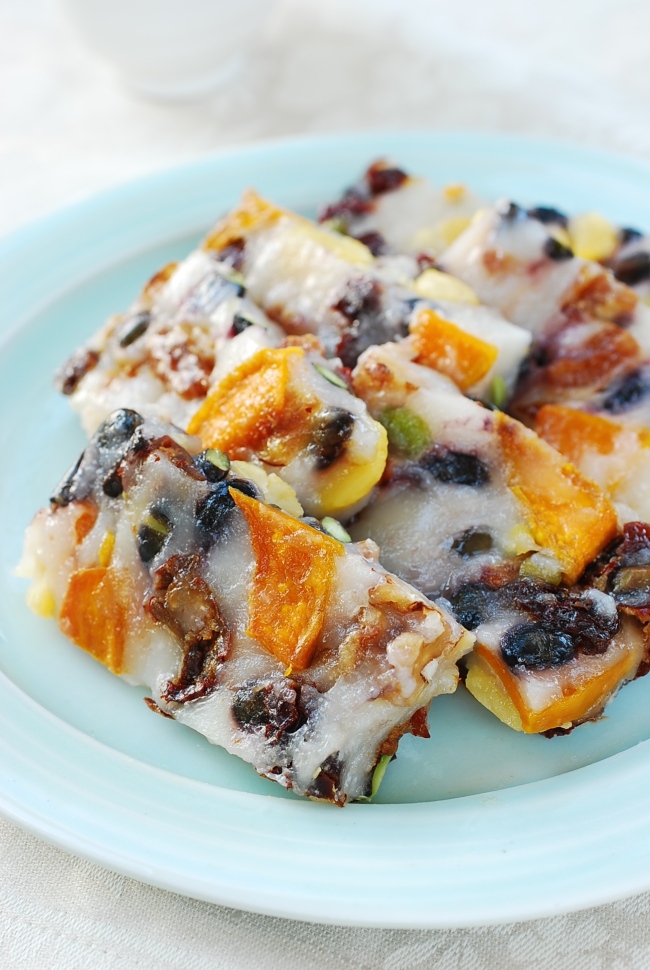This rice cake, yeongyang chaltteok, is one of the easiest rice cakes you can make at home. No kneading, no shaping, no pounding, and no special tool other than a steamer is required. Yeongyang means healthy, and chal-tteok refers to sticky, chewy rice cakes that are made with glutinous rice (sweet rice) powder, chapssal garu.
Traditionally, black soybeans (called seoritae or geomjeongkong), dried jujube (Korean dates, daechu), and dried pumpkin strips (hobak ogari) are added to this type of rice cake. These days, it’s also loaded with various nuts and/or other dried fruits such as raisins and dried persimmons (gotgam), hence the name yeongyang tteok.
This recipe is very flexible! You can vary the amounts of the rice powder or other ingredients. Any combination of sweet rice powder, beans, nuts, and dried fruits will give you tasty, healthy rice cakes!
 |
Yeongyang chaltteok (healthy sweet rice cake) (Korean Bapsang) |
Ingredients:1 cup soaked black soybeans, seoritae, (or kidney beans)
12 jujubes, dried Korean dates, daechu, (or 1/2 cup raisins, dried cranberries or persimmons)
1/2 cup dried kabocha strips (or other type of pumpkin)
10 chestnuts, quartered
1/2 cup walnuts, quartered
5 cups wet sweet rice powder (defrost at room temperature, if frozen)
3 tablespoons sugar
Prepare the beans by soaking in warm water for a few hours. Rinse the jujubes and cut each one around the seed into 3 to 4 pieces. Rinse the dried kabocha and rehydrate by adding a tablespoon or two of water at a time, until softened. Prepare the nuts.
In a large bowl, combine the rice powder and sugar. Mix well by hand or a whisk until everything is well incorporated. Add 2 tablespoons of water and rub the powder between your palms, breaking the big clumps, to evenly distribute the moisture. You don’t need to try to break up small clumps.
Add all the other ingredients and gently toss to evenly distribute.
Fill a steamer (or a pot) with water two thirds of the way. Prepare the steamer insert (or bamboo steamer) with a wet linen/cotton cloth (or cheesecloth). Turn the heat on.
When it starts to steam, add the mixture to the steamer insert with a large spoon. Even the top out, but do not pack. If your cloth hangs down low, fold it over to cover the mixture. Unless using a bamboo steamer, fully cover the top with another cloth before putting the lid on. (This will prevent the water generated by steam from dripping on the rice cake.)
Steam for 30 minutes, and then remove the steamer insert from the heat.
When it’s cool enough to handle, flip it over onto a cutting board. Remove the cloth. Shape the rice cake to a rectangle if desired. Wet your hands before touching the rice cake. Cut into serving size pieces.
Keep it in an airtight container if serving within a day or two. To store for a longer period, individually wrap and freeze the rice cake. For best results, do this within a few hours of making. Simply leave it out at room temperature until it softens before serving, or you can briefly defrost it in the microwave.
For more recipes visit
www.koreanbapsang.com.
By Ro Hyo-sun





![[Exclusive] Hyundai Mobis eyes closer ties with BYD](http://res.heraldm.com/phpwas/restmb_idxmake.php?idx=644&simg=/content/image/2024/11/25/20241125050044_0.jpg)
![[Herald Review] 'Gangnam B-Side' combines social realism with masterful suspense, performance](http://res.heraldm.com/phpwas/restmb_idxmake.php?idx=644&simg=/content/image/2024/11/25/20241125050072_0.jpg)

